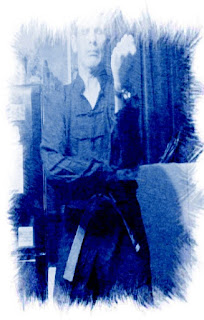It isn't a popular concept that the roots of Okinawan Kobudo and Tiy are intertwined. In his recent book "The transformation of Tiy", Sensei Koei Nohara states (p38 English edition), "Further, bo kata can be performed by using ones hands instead of using a bo and, vice versa, tiy kata can be performed using a bo. Bo kata that were developed in the 13th century such as Maeda no kon, Shirataru no kon, and Ufugusku no kon are basically the same as Maeda no te, Shirataru no te, and Ufugusku no te." There is no reference material given with this, but given the dates and the oral, secretive and ritual nature of the history of Karate, I don't suppose that is too unusual.
I wanted to see whether this perception was commonly held, and posted in a group on Facebook to see what other karateka thought. The response was fairly negative, as I guess the possibility goes against most people's preconceptions, which I guess is that Kobudo and Karate are different disciplines. Still, it piqued my interest and I decided to look further into it. Being relative novice to Karate, I don't have a massive library of material to draw on, so turned to the Internet and found a YouTube video of a kata: Maeda Bo Chugata
I asked my own Sensei whether he was familiar with this particular kata, but he wasn't so there I left things for a while, until I enquired of Andreas Quast as to whether there was a time line for Okinawan history, which he kindly provided Periodization of Ryukyuan History I also asked him whether he had come across the Maeda bo kata. He said that he had, and had trained with the person in the video. He suggested that if I wanted to know more, I should get in touch with Cezar Borkowski. Cezar kindly responded and advised that Maeda is indeed the oldest extanct bo kata, with a provenance of over 500 years as a continuous fighting tradition, "now under the direction of Tomimoto and Arakaki sensei". He also provided a link to his own article: The Revolution of Ryu Kyu Kobudo.
Cezar made comment on the video of the Maeda kata that "For over 500 years Maeda-bojutsu has been preserved and practiced in the Maeda village of Urasoe-shi. This highly combative tradition, focuses on the bo, but also includes sai, as well as a close-quarter empty hand grappling methods. Arakaki-sensei (senior disciple of Tomimoto Yuko) performs the middle level form."
On the origins of the bo in his article, he indicates of all the Kobudo weapons in use today, that the bo is the one that is most uniquely Okinawan" To quote from his article "The bo is an ancient implement employed in early Shamanistic rituals. At the religion’s core is the sanctity of seji or a deep spiritual power. Devotees believe that the seji is the source of power for the shaman, warrior or ruler.
Shamanistic ceremonies included sacred omoro songs and kami dances that were often performed with a bo. Special bo dances were an integral component of festivals celebrating terukawa (sun), terushino (moon) and teda (sunshine). These elaborate productions also marked the harvest, commemorated special historical events and honoured ancestors. Colourfully costumed village strongmen carrying bo would perform martial-like routines to the pulsating rhythm of cymbals and drums. In my view, the similarity of these routines to weapons kata is unmistakable, and these dances were likely the forerunners of modern kobudo forms."
Later in his article, he cites that there are "more than one hundred village bo routines exist. They are often performed by folkloric groups at Okinawan festivals which include the Tsunahiki (giant tug-of- war), dragon boat races, National Sport and Fitness Day, as well as many local celebrations. These exciting weapons exhibitions often include musical accompaniment in the form of cymbal clanging, Taiko drumming, and a unique Okinawan style of whistling."
Observations and conclusions : From Cezar Borowski's article, it is clear to see that much of the antique cultural use and context for the use of the bo has been passed down in Okinawan village tradition. From the comment made by Cezar Borowski on the Maeda bo Chugata video, the family of kata not only include bo, but also sai and "close quarter empty hand grappling methods", could this be construed as a form of Tiy?
I would suggest that the Okinawan village routines (including dance) might well contain the elemental roots of both Okinawan bojutsu and Tiy. On a historical note, whilst Sensei Nohara places the Maeda Kata in the 13th Century and the 500 year figure quoted by Cezar Borowski places the kata round about the 15th century, these both fall within the Gusuku-jidai period (early period of old Ryukyu period) as shown in Andreas Quast's timeline.






